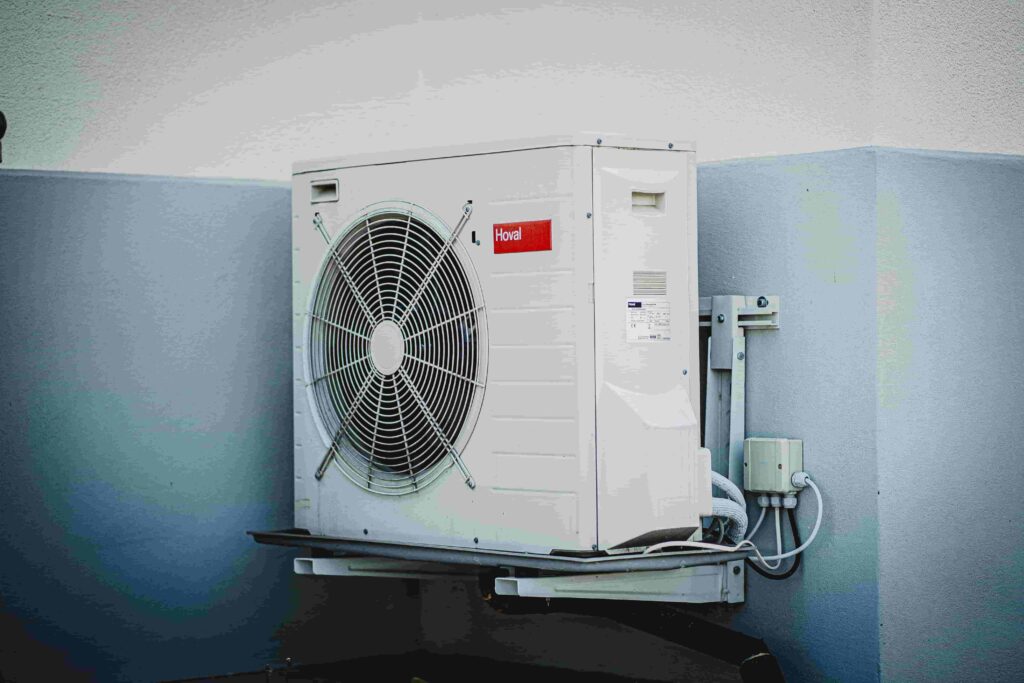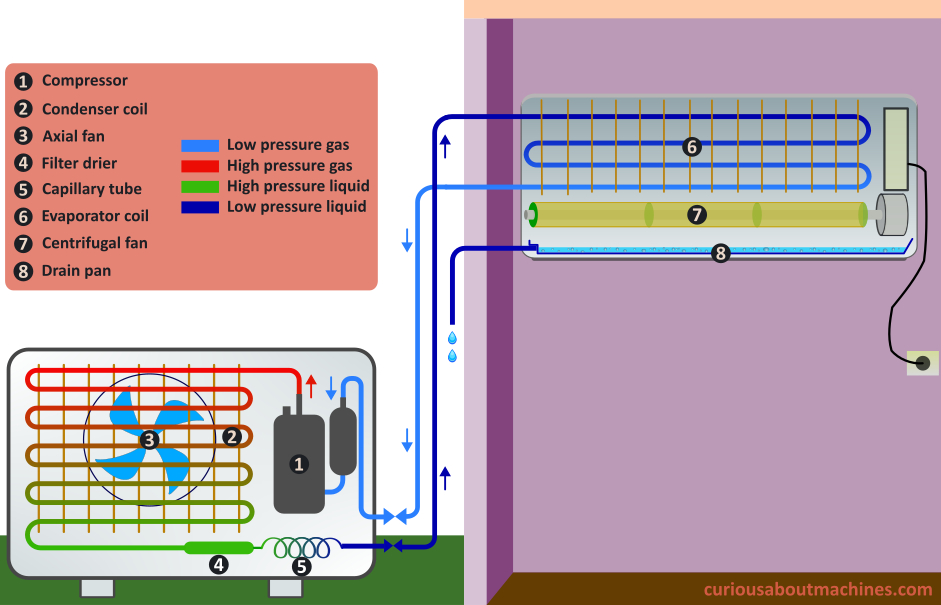By Adven Simarmata. Last updated on June 9th, 2023.
The main function of an air conditioner is to cool the indoor room. It is worth noting that some air conditioners can also heat the room, and even some of them can dehumidify or humidify the air. However, in this article, the discussion will be focused on how air conditioners cool the room.
The working principle of an air conditioner is similar to the one of a refrigerator. Air conditioners cool the indoor room by transferring heat from the indoor room to the outdoor environment. And just like in the refrigerator, there is a circuit in the air conditioner through which refrigerant flows continuously. In this circuit, the refrigerant alternately changes its phase from liquid to gas (evaporates) and from gas to liquid (condenses). This cycle of phase changes enables the refrigerant to absorb heat from the indoor room (during the evaporation) and discharge the heat to the outdoor environment (during the condensation). This cycle, called the vapor compression cycle, is continuously repeated to gradually remove the excessive heat in the room until the room reaches the desired cool temperature.
A typical domestic air conditioner, usually called the split-type air conditioner, consists of two units, namely the indoor unit and the outdoor unit, as can be seen in Figure 1. As the name suggests, the indoor unit is placed inside the room to be cooled, usually mounted on the wall. The outdoor unit is placed outside the room, having contact with ambient air.


The main components of the vapor compression cycle are the compressor, condenser, expansion valve, and evaporator. The significant additional components that the air conditioners have but the refrigerators do not are fans; one unit is located near the condenser, and one other unit is near the evaporator. Figure 2 shows the main components of a split-type air conditioner.

The evaporator must be part of the indoor unit because it is the component through which the refrigerant absorbs the heat from the indoor room. And the condenser must be part of the outdoor unit because it is the component through which the refrigerant ejects the heat to the outdoor environment. The other main components, i.e., the compressor and expansion valve, can be part of either the indoor or outdoor unit depending on the model/brand of the air conditioner.
Four Stages of Vapor Compression Cycle in an Air Conditioner
Let’s look at the four stages of the vapor compression cycle in an air conditioner. Figure 3 shows the phase shifts and pressure changes between the four main components.

1. Compressor
A low-pressure refrigerant in the gaseous state enters the compressor. The compressor compresses the refrigerant adiabatically. As a result, the pressure of the gas increases, and so does the temperature.
2. Condenser
The high-pressure, high-temperature gas enters the condenser. In the condenser, the gas loses heat to the surroundings. As a result, the refrigerant condenses or changes its phase into a high-pressure liquid.
3. Expansion valve
The high-pressure liquid enters the expansion valve. [In the illustration in Fig. 2, the type of expansion valve used is the capillary tube.] The expansion valve restricts the flow of the liquid, thus reducing its pressure and temperature. Hence, a low-pressure, low-temperature liquid leaves the expansion valve.
4. Evaporator
The low-pressure liquid with a temperature lower than the room temperature enters the evaporator. Air from the indoor room is sucked through a grille to pass through the evaporator coil. Since the temperature of the air is higher than the temperature of the refrigerant that flows through the evaporator coil, the heat from the air is absorbed by the refrigerant. This heat absorption turns the refrigerant completely into a low-pressure gas (evaporation). The low-pressure gas leaves the evaporator and goes back to the compressor, and the vapor compression cycle is repeated. The air that has passed through the evaporator coil becomes colder and is returned back to the room through another grille. The more repetitions of the cycle, the more heat is transferred from the room to the outdoor area; hence, the room gets colder. In non-inverter air conditioners, the cycle will stop momentarily when the temperature of the room is cold enough, and it will be started again when the temperature is too hot.
Additional Components of an Air Conditioner
1. Axial fan
The axial fan blows air to the condenser coil to quicken the transfer of heat from the refrigerant to the surroundings.
2. Filter drier
The function of the filter drier is to trap contaminants in the refrigerant, such as dirt and moisture. The dirt and moisture may contaminate the refrigerant when the air conditioner is first installed or anytime the circuit is disassembled. The filter drier needs to be replaced periodically, typically every two years, depending on the manufacturer’s recommendations. Note that the filter drier is fitted in the liquid line of the circuit, more precisely between the condenser and expansion valve.
3. Centrifugal fan
The centrifugal fan is used to move the warm indoor air to pass through the evaporator coil.
4. Condensate drain pan
Air conditioners usually remove humidity from the room that is cooled. The condensate drain pan collects the condensate (moisture that has been condensed). The condensate then will be discharged outdoors through the drain pipe.
Conclusion
Similar to refrigerators, air conditioners provide cooling to the indoor room by circulating refrigerant in the vapor-compression refrigeration circuit. In the circuit, the refrigerant alternately changes its phase from liquid to gas and vice versa. When the refrigerant changes its phase from liquid to gas (evaporates), it takes up the heat from the air inside the room. Meanwhile, when the refrigerant changes its phase from gas to liquid (condenses), it releases the heat to the outdoor environment.

Leave a Reply